Papers by daniele casalbore
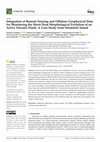
Remote Sensing
The Sciara del Fuoco (SdF) collapse scar at Stromboli is an active volcanic area affected by rapi... more The Sciara del Fuoco (SdF) collapse scar at Stromboli is an active volcanic area affected by rapid morphological changes due to explosive/effusive eruptions and mass-wasting processes. The aim of this paper is to demonstrate the importance of an integrated analysis of multi-temporal remote sensing (photogrammetry, COSMO-SkyMed Synthetic Aperture Radar amplitude image) and marine geophysical data (multibeam and side scan sonar data) to characterize the main morphological, textural, and volumetric changes that occurred along the SdF slope in the 2020–2021 period. The analysis showed the marked erosive potential of the 19 May 2021 pyroclastic density current generated by a crater rim collapse, which mobilized a minimum volume of 44,000 m3 in the upper Sciara del Fuoco slope and eroded 350,000–400,000 m3 of material just considering the shallow-water setting. The analysis allowed us also to constrain the main factors controlling the emplacement of different lava flows and overflows duri...
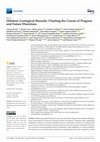
Oceans
Offshore geological hazards can occur in any marine domain or environment and represent a serious... more Offshore geological hazards can occur in any marine domain or environment and represent a serious threat to society, the economy, and the environment. Seismicity, slope sedimentary instabilities, submarine volcanism, fluid flow processes, and bottom currents are considered here because they are the most common hazardous processes; tsunamis are also examined because they are a secondary hazard generated mostly by earthquakes, slope instabilities, or volcanic eruptions. The hazards can co-occur and interact, inducing a cascading sequence of events, especially in certain contexts, such as tectonic indentations, volcanic islands, and canyon heads close to the coast. We analyze the key characteristics and main shortcomings of offshore geological hazards to identify their present and future directions for marine geoscience investigations of their identification and characterization. This review establishes that future research will rely on studies including a high level of multidisciplina...
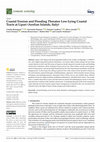
Remote Sensing
Lipari is the largest and most populated island in the Aeolian Archipelago, a UNESCO site, and a ... more Lipari is the largest and most populated island in the Aeolian Archipelago, a UNESCO site, and a highly frequented touristic destination. As in many other insular settings, the low-lying coastal stretches in the E and NE sectors of Lipari are locally exposed to coastal erosion and flooding, enhanced by subsidence effects leading to local sea level rise. Most of these coastal sectors appear critical, being narrow and increasingly threatened by the risk of permanent inundation and beach disappearance. In this study, this setting is placed in the wider context of the decadal evolution of the main beaches, analysed through a multidisciplinary approach, which includes remote sensing techniques (aero-photogrammetry, unmanned aerial vehicle survey, and satellite data), offshore geophysical surveys (high-resolution multibeam bathymetry), and field observations. The results show a variable interaction in space and time between natural and anthropogenic factors in the long- and mid-term evolu...

Under the Sea: Archaeology and Palaeolandscapes of the Continental Shelf, 2017
After the Last Glacial Maximum, some 21,000 years BP, the sea level rose from −130 m to its prese... more After the Last Glacial Maximum, some 21,000 years BP, the sea level rose from −130 m to its present-day position. This process of marine transgression inundated or eroded palaeolandscapes to varying degrees, resulting in the landward movement of the shoreline. The transgression velocity (TV), i.e., the velocity at which the shoreline migrated landwards, depends on evaluating the balance between the rate of relative sea level rise and the slope of the transgressed palaeotopography. It has a key role in determining the possibilities for reconstructing palaeoenvironments, the potential preservation of archaeological sites and the socioeconomic and psychological impact of sea-level rise on past human populations. In this chapter we present a simple conceptual and computational approach to reconstructing the transgression velocity on shelf areas, making use of Digital Terrain Models (DTMs) of seafloor topography coupled with relative sea level curves, and discuss the different outcomes and limitations at different spatial scales, ranging from the continental (European seas) to the ultra-local scale. 3.1 Introduction The interest for prehistoric archaeologists in continental shelves is steadily increasing as it becomes clear that present-day submerged shelf areas afforded palaeolandscapes for human exploitation with a range of coastal, marine and terrestrial resources as well as access to transportation and migration Chapter 3
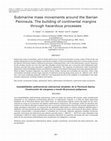
espanolLas inestabilidades sedimentarias submarinas, como en todos los oceanos del mundo, estan a... more espanolLas inestabilidades sedimentarias submarinas, como en todos los oceanos del mundo, estan ampliamente presentes en los margenes continentales ibericos. La disposicion irregular o la falta de datos adquiridos alrededor de la Peninsula Iberica hace dificil tener un conocimiento preciso acerca del papel de los movimientos en masa en la evolucion del registro sedimentario submarino. Sin embargo, todos los estudios realizados en las ultimas decadas muestran que son un proceso sedimentario esencial que puede representar un riesgo geologico importante. La mayoria de los depositos observados en ambos margenes, Mediterraneo y Atlantico, han sido genericamente definidos como de transporte de masa, pero flujos de derrubios y deslizamientos (rotacionales y translacionales) o turbiditas son comunes. Algunos ejemplos notables involucran grandes volumenes de sedimentos que afectan grandes areas (~ 500 km3 / ~ 6x104 km2 ) pero depositos mas moderados ( EnglishSubmarine mass movements, such as...
Stromboli is one of the most active volcanoes in the world, extensively monitored and studied in ... more Stromboli is one of the most active volcanoes in the world, extensively monitored and studied in the last few decades. Many tsunamigenic landslides (sub-aerial and/or submarine) have taken place; at least seven have occurred in the last 150 years and a devastating one is believed to have reached the coast of Naples, at more than 200 km distance, during the Middle Ages. Because the level of activity of the volcano has remained similar ever since and the likelihood of such disastrous events is not negligible, the hazard related to tsunamigenic mass flows in this area needs to be carefully assessed.
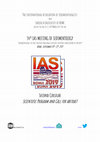
s of Plenary Lectures .............................................................................. more s of Plenary Lectures ............................................................................................................................... 22 Pre-meeting activities ........................................................................................................................................... 25 Intra-meeting activities (on Thursday, Sept. 12) .................................................................................................. 25 Post-meeting activities ......................................................................................................................................... 27 Field trip location (map) ....................................................................................................................................... 28 Pre-conference field trip description .................................................................................................................... 29 Intra-conference field description .......
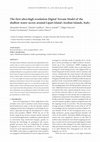
Annals of Geophysics, 2015
Very high resolution bathymetric map obtained through multibeam echo-sounders data are crucial t... more Very high resolution bathymetric map obtained through multibeam echo-sounders data are crucial to generate accurate Digital Terrain Models from which the morphological setting of active volcanic areas can be analyzed in detail. Here we show and discuss the main results from the first multibeam bathymetric survey performed in shallow-waters around the island of Lipari, the largest and the most densely populated of the Aeolian Islands (southern Italy). Data have been collected in the depth range of 0.1-150 m and complete the already existent high-resolution multibeam bathymetry realized between 100 and 1300 m water depth. The new ultra-high resolution bathymetric maps at 0.1-0.5 m provide new insights on the shallow seafloor of Lipari, allowing to detail a large spectrum of volcanic, erosive-depositional and anthropic features. Moreover, the presented data allow outlining the recent morphological evolution of the shallow coastal sector of this active volcanic island, indicating the p...
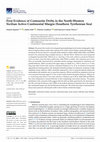
Journal of Marine Science and Engineering, 2021
We present the results of an integrated geomorphological and seismo-stratigraphic study based on ... more We present the results of an integrated geomorphological and seismo-stratigraphic study based on high resolution marine data acquired in the north-western Sicilian continental margin. We document for the first time five contourite drifts (marked as EM1a, EM2b, EM2, EM3a, and EM3b), located in the continental slope at depths between ca. 400 and 1500 m. EM1a,b have been interpreted as elongated mounded drifts. EM1a,b are ca. 3 km long, 1.3 km wide, and have a maximum thickness of 36 m in their center that thins northwards, while EM1b is smaller with a thickness up to 24 m. They are internally characterized by mounded seismic packages dominated by continuous and parallel reflectors. EM2 is located in the upper slope at a depth of ca. 1470 m, and it is ca. 9.3 km long, more than 3.9 km wide, and has a maximum thickness of ca. 65 m. It consists of an internal aggradational stacking pattern with elongated mounded packages of continuous, moderate to high amplitude seismic reflectors. EM2 i...
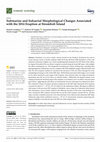
Remote Sensing, 2021
Stromboli is an active insular volcano located in the Southern Tyrrhenian Sea and its recent volc... more Stromboli is an active insular volcano located in the Southern Tyrrhenian Sea and its recent volcanic activity is mostly confined within the Sciara del Fuoco (SdF, hereafter), a 2-km wide subaerial–submarine collapse scar, which morphologically dominates the NW flank of the edifice. In August-November 2014, an effusive eruption occurred along the steep SdF slope, with multiple lava flows reaching the sea. The integration of multisensor remote sensing data, including lidar, photogrammetric, bathymetric surveys coupled with SAR amplitude images collected before and after the 2014 eruption enabled to reconstruct the dynamics of the lava flows through the main morphological changes of the whole SdF slope. Well-defined and steep-sided ridges were created by lava flows during the early stages of the eruption, when effusion rates were high, favoring the penetration into the sea of lava flows as coherent bodies. Differently, fan-shaped features were emplaced during the declining stage of th...
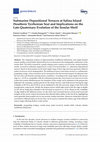
Geosciences, 2018
The integrated analysis of high-resolution multibeam bathymetry and single-channel seismic profil... more The integrated analysis of high-resolution multibeam bathymetry and single-channel seismic profiles around Salina Island allowed us to characterize the stratigraphic architecture of the insular shelf. The shelf is formed by a gently-sloping erosive surface carved on the volcanic bedrock, mostly covered by sediments organized in a suite of terraced bodies, i.e. submarine depositional terraces. Based on their position on the shelf, depth range of their edge and inner geometry, different orders of terraces can be distinguished. The shallowest terrace (near-shore terrace) is a sedimentary prograding wedge, whose formation can be associated to the downward transport of sediments from the surf zone and shoreface during stormy conditions. According to the range depth of the terrace edge (i.e., 10-25 m, compatible with the estimated present-day, local storm-wave base level in the central and western Mediterranean), the formation of this wedge can be attributed to the present-day highstand. By assuming a similar genesis for the deeper terraces, mid-shelf terraces having the edge at depths of 40-50 m and 70-80 m can be attributed to the late and early stages of the Post-LGM transgression, respectively. Finally, the deepest terrace (shelf-edge terrace) has the edge at depths of 130-160 m, being thus referable to the lowstand occurred at ca. 20 ka. Based on the variability of edge depth in the different sectors, we also show how lowstand terraces can be used to provide insights on the recent vertical movements that affected Salina edifice in the last 20 ka, highlighting more generally their possible use for neo-tectonic studies elsewhere. Moreover, being these terraces associated to different paleo-sea levels, they can be used to constrain the relative age of the different erosive stages affecting shallow-water sectors.
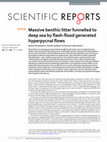
Scientific Reports, 2019
Marine litter is an emerging environmental threat affecting all world’s oceans including the deep... more Marine litter is an emerging environmental threat affecting all world’s oceans including the deep seafloor, where the extent of the phenomenon is still largely unknown. We report the spatial patterns of macro-litter distribution within the Messina Strait’s channels (Central Mediterranean), focusing on the transfer mechanisms responsible for its emplacement, a key information to better understand litter distribution. Litter is patchy but pervasive on all surveyed channels, reaching densities up to ~200 items/10 m, the highest reported for the deep sea until now. Litter is often arranged in large accumulations formed by hundreds of land-sourced items, mixed to vegetal and coarse-grained debris, indicating an emplacement from sedimentary gravity flows. Such impressive amount of litter can be explained by the superposition of a very efficient source-to-sink sedimentary transport and a strong urbanization of the coastal area. These findings point out that macro-benthic litter pollution i...
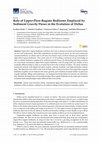
Journal of Marine Science and Engineering, 2019
Upper-flow-regime bedforms and their role in the evolution of marine and lacustrine deltas are no... more Upper-flow-regime bedforms and their role in the evolution of marine and lacustrine deltas are not well understood. Wave-like undulations on delta foresets are by far the most commonly reported bedforms on deltas and it will take time before many of these features get identified as upper-flow-regime bedforms. This study aims at: (1) Providing a summary of our knowledge to date on deltaic bedforms emplaced by sediment gravity flows; (2) illustrating that these features are most likely transitional upper-flow-regime bedforms; and (3) using field case studies of two markedly different deltas in order to examine their role in the evolution of deltas. The study combines numerical analysis with digital elevation models, outcrop, borehole, and high-resolution seismic data. The Mazzarrà river delta in the Gulf of Patti, Italy, is selected to show that upper-flow-regime bedforms in gullies can be linked to the onset, growth, and evolution of marine deltas via processes of gully initiation, f...
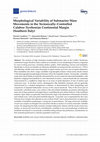
The acquisition of high resolution morpho-bathymetric data on the Calabro Tyrrhenian contine... more The acquisition of high resolution morpho-bathymetric data on the Calabro Tyrrhenian continental margin (Southern Italy) enabled us to identify several mass-wasting processes, including shallow gullies, shelf-indenting canyons and landslides. In particular, we focus our attention on submarine landslides occurring from the coast down to -1700 m, with mobilized volumes ranging from some hundreds up to tens of millions of cubic meters. These landslides also show a large variability of geomorphic features in the headwall, translational and toe domain. Based on their morphology and distribution, four main classes of coastal/submarine landslides have been recognized: a) rocky coastal/shallow-water failures characterized by large hummocky deposits offshore; b) large-size and isolated scars with associated landslide deposits, mostly occurring on open slope environment and lower part of tectonically-controlled escarpments; c) a linear array of coalescent and nested landslide scars occur...
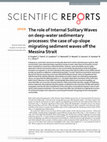
Scientific Reports, 2016
Subaqueous, asymmetric sand waves are typically observed in marine channel/canyon systems, tidal ... more Subaqueous, asymmetric sand waves are typically observed in marine channel/canyon systems, tidal environments, and continental slopes exposed to strong currents, where they are formed by current shear resulting from a dominant unidirectional flow. However, sand-wave fields may be readily observed in marine environments where no such current exists; the physical processes driving their formation are enigmatic or not well understood. We propose that internal solitary waves (ISWs) induced by tides can produce an effective, unidirectional boundary “current” that forms asymmetric sand waves. We test this idea by examining a sand-wave field off the Messina Strait, where we hypothesize that ISWs formed at the interface between intermediate and surface waters are refracted by topography. Hence, we argue that the deflected pattern (i.e., the depth-dependent orientation) of the sand-wave field is due to refraction of such ISWs. Combining field observations and numerical modelling, we show tha...

Terra Nova, 2017
Archaeological and instrumental data indicate that the southern sector of the volcanic island of ... more Archaeological and instrumental data indicate that the southern sector of the volcanic island of Lipari has been subsiding for the last 2100 years due to isostatic and tectonic factors, at variable rates of up to ~11 mm a−1. Based on this data, a detailed marine flooding scenario for 2100 AD is provided for the bay of Marina Lunga in the eastern part of the island from (1) an ultra‐high‐resolution Digital Terrain and Marine Model (DTMM) generated from multibeam bathymetry (MB) and Unmanned Aerial Vehicles (UAV), (2) the rate of land subsidence from Global Positioning System (GPS) data and (3) the regional sea‐level projections of the International Panel on Climate Change (IPCC). When land subsidence is considered, the upper bound of sea‐level rise is estimated at 1.36 m and 1.60 m for RCP4.5 and RCP8.5 climate change scenarios, respectively. Here, we show the expected impact of marine flooding at Lipari for the next 85 years and discuss the hazard implications for the population liv...
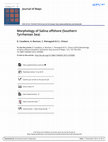
Journal of Maps, 2015
In this paper, we present the first complete morphological map of the Salina offshore at a scale ... more In this paper, we present the first complete morphological map of the Salina offshore at a scale of 1:100,000. The submarine flanks of the Salina edifice extend down to −650 to −1300 m, are steep and characterized by an uneven morphology due to the presence of volcanic and erosivedepositional features. The volcanic features cover ∼30% of the submarine portion and include volcanic cones and bedrock outcrops. The remaining ∼70% is affected by a wide series of erosive-depositional features. Among these, features related to Late Quaternary sea level fluctuations comprise the insular shelf surrounding the island and overlying submarine terraced depositional sequences. Mass-wasting features include landslide scars, channels, fanshaped deposits and waveforms. The presented map provides useful insights for a better understanding of the morphological evolution of the edifice ARTICLE HISTORY
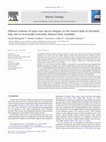
Marine Geology, 2009
New detailed swath bathymetry and long-range side scan sonar data on the submerged flanks of Stro... more New detailed swath bathymetry and long-range side scan sonar data on the submerged flanks of Stromboli, integrated with seismic data and seabed sampling, indicate that repeated lateral instability processes occurred on the eastern flank of the volcano, although no debris avalanche deposits were known before the high-resolution exploration of the seabed. This flank of the island is opposite to the northwestern side, more evidently affected by repeated flank collapses, and this setting is evidence for a structurally-controlled, bilateral flank instability of the volcanic edifice. Evidence of at least two large-scale lateral collapses is represented by a superficial hummocky megablock field, partially outcropping on the middle-lower eastern submerged slope, and by a chaotic unit (estimated volume is 1-2 km 3) actually embedded within the volcaniclastic sequence at the foot of the submerged flank. A main submarine scar open towards the SE is carved in the upper slope on the eastern flank of the island, being partially filled with gravity flow deposits owing to the present-day depositional setting of the volcano's submerged flank. A morphological continuity can be envisaged between this submerged scar and an inferred subaerial one, likely encompassing the Rina Grande depression and several minor nested landslide scars recognized on the eastern Stromboli flank. A spatial and temporal reconstruction of possible events is proposed. The chaotic debris avalanche unit, buried within the volcaniclastic apron at the slope base and partially reworked in its distal part within the Stromboli Canyon floor, is thought to be the result of a lateral collapse event (called Paleostromboli Lateral Collapse, PLC, as it likely occurred in the earlier stages of the subaerial development of the island) affecting a wide sector of the eastern Stromboli flank. The megablock field might instead result from a more superficial debris avalanche deposit, partially eroded by gravity flows currently acting on the seabed. It is tentatively related to the recent subaerial scar morphologies affecting the Vancori units (and for this reason named Vancori Lateral Collapse, VLC). Displaced materials have lower volume and mobility than the PLC.
Uploads
Papers by daniele casalbore